The Role of Thermal Accumulation on the Fabrication of Diffraction Gratings in Ophthalmic PHEMA by Ultrashort Laser Direct Writing
Abstract
:1. Introduction
2. Experimental System
2.1. Laser Setup
2.2. Characterization Techniques
3. Results and Discussion
3.1. Laser Processing
3.1.1. Thermal Accumulation by Ultrashort Laser Pulses: Background
3.1.2. Laser Processing in Non-Thermal Regime
3.1.3. Laser Processing in Thermal Regime
3.2. Microstructural Characterization
3.3. Optical Characterization
4. Conclusions
Author Contributions
Funding
Conflicts of Interest
References
- Rubinstein, M.; Colby, R.H. Polymer Physics, 1st ed.; Oxford University Press Inc: New York, NY, USA, 2003. [Google Scholar]
- Schnabel, W. Polymers and Light; Wiley-VCH Verlag GmbH: Weinheim, Germany, 2007. [Google Scholar]
- Hussain, F.; Hojjati, M.; Okamoto, M.; Gorga, R.E. Polymer-matrix Nanocomposites, processing, manufacturing, and application: An overview. J. Compos. Mater. 2006, 40, 1511–1575. [Google Scholar] [CrossRef]
- Scholz, C. Polymers for Biomedicine: Synthesis, Characterization and Applications; John Wiley & Sons, Inc.: Hoboken, NJ, USA, 2017. [Google Scholar]
- Deligkaris, K.; Tadele, T.S.; Olthuis, W.; Berg, A. Hydrogel devices for biomedical applications. Sens. Actuators B 2010, 147, 765–774. [Google Scholar] [CrossRef]
- Hunter, A.C.; Moghimi, M.S. Smart polymers in drug delivery: A biological perspective. Polym. Chem. 2017, 8, 41–51. [Google Scholar] [CrossRef] [Green Version]
- Calo, E.; Khutoryanskiy, V.V. Biomedical applications of hydrogels: A review of patents and commercial products. Eur. Polym. J. 2015, 65, 252–267. [Google Scholar] [CrossRef] [Green Version]
- Maulvi, F.A.; Soni, T.G.; Sha, D.O. A review on therapeutic contact lenses for ocular drug delivery. Drug Deliv. 2016, 23, 3017–3026. [Google Scholar] [CrossRef] [PubMed]
- Allen, N.S. Photochemistry and Photophysics of Polymeric Materials; John Wiley & Sons, Inc.: Hoboken, NJ, USA, 2010. [Google Scholar]
- Belluchi, R. An introduction to intraocular lenses: Material, optics, haptics, design and aberration. Cataract 2013, 3, 38–55. [Google Scholar]
- Misawa, H.; Juodkazis, S. 3D Laser Microfabrication; Wiley-VCH Verlag: Weinheim, Germany, 2006. [Google Scholar]
- Osellame, R.; Cerullo, G.; Ramponi, R. Femtosecond Laser Micromachining, Photonic and Microfluidic Devices in Transparent Materials; Springer: Berlin/Heidelberg, Germany, 2012. [Google Scholar]
- Davis, K.M.; Miura, K.; Sugimoto, N.; Hirao, K. Writing waveguides in glass with a femtosecond laser. Opt. Lett. 1996, 21, 1729–1731. [Google Scholar] [CrossRef]
- Nolte, S.; Will, M.; Burghoff, J.; Tuennermann, A. Femtosecond waveguide writing: A new avenue to three-dimensional integrated optics. Appl. Phys. A 2003, 77, 109–111. [Google Scholar] [CrossRef]
- Ding, L.; Blackwell, R.; Künzler, J.F.; Knox, W.H. Large refractive index change in silicone-based and non-silicone-based hydrogel polymers induced by femtosecond laser micro-machining. Opt. Express 2006, 14, 11901–11909. [Google Scholar] [CrossRef]
- Gamaly, E.G.; Juodkazis, S.; Misawa, H.; Luther-Davies, B.; Rode, A.V.; Hallo, L.; Nicolai, P.; Tikhonchuk, V.T. Formation of nano-voids in transparent dielectrics by femtosecond laser. Curr. Appl. Phys. 2008, 8, 412–415. [Google Scholar] [CrossRef]
- Ding, L.; Blackwell, R.I.; Künzler, J.F.; Knox, W.H. Femtosecond laser micromachining of waveguides in silicone-based hydrogel polymers. Appl. Opt. 2008, 47, 3100–3108. [Google Scholar] [CrossRef] [PubMed]
- Ding, L.; Jani, D.; Linhardt, J.; Künzler, J.F.; Pawar, S.; Labenski, G.; Smith, T.; Knox, W.H. Large enhancement of femtosecond laser micromachining speed in dye-doped hydrogel polymers. Opt. Express 2008, 16, 21914–21921. [Google Scholar] [CrossRef] [PubMed]
- Ding, L.; Jani, D.; Linhardt, J.; Künzler, J.F.; Pawar, S.; Labenski, G.; Smith, T.; Knox, W.H. Optimization of femtosecond laser micromachining in hydrogel polymers. J. Opt. Soc. Am. 2009, 26, 1679–1687. [Google Scholar] [CrossRef]
- Benayas, A.; Silva, W.F.; Rodenas, A.; Jacinto, C.; Vázquez de Aldana, J.; Chen, F.; Tan, Y.; Thomson, R.R.; Psaila, N.D.; Reid, D.T.; et al. Ultrafast laser writing of optical waveguides in ceramic Yb:YAG: A study of thermal and non-thermal regimes. Appl. Phys. A 2011, 104, 301–309. [Google Scholar] [CrossRef]
- Sola, D.; Escartin, A.; Cases, R.; Peña, J.I. Crystal growth induced by Nd:YAG laser irradiation in patterning glass ceramic substrates with dots. Opt. Mater. 2011, 33, 728–734. [Google Scholar] [CrossRef]
- Xu, L.; Knox, W.H. Lateral gradient index microlenses written in ophthalmic hydrogel polymers by femtosecond laser machining. Opt. Mater. Express 2011, 1, 1416–1424. [Google Scholar] [CrossRef]
- Sola, D.; Martinez de Mendibil, J.; Vazquez de Aldana, J.R.; Lifante, G.; Balda, R.; de Aza, A.H.; Pena, P.; Fernandez, J. Stress-induced buried waveguides in the 0.8CaSiO3-0.2Ca3(PO4)2 eutectic glass doped with Nd3+ ions. Appl. Surf. Sci. 2013, 278, 289–294. [Google Scholar] [CrossRef]
- Chen, F.; Vazquez de Aldana, J.R. Optical waveguides in crystalline dielectric materials produced by femtosecond-laser micromachining. Laser Photonics Rev. 2014, 8, 251–275. [Google Scholar] [CrossRef]
- Martinez de Mendivil, J.; Sola, D.; Vazquez de Aldana, J.R.; Lifante, G.; de Aza, A.H.; Pena, P.; Peña, J.I. Ultrafast direct laser writing of cladding waveguides in the 0.8CaSiO3-0.2Ca3(PO4)2 eutectic glass doped with Nd3+ ions. J. Appl. Phys. 2015, 117, 043104–1/5. [Google Scholar] [CrossRef]
- Srinivasan, R.; Mayne-Banton, V. Self-developing photoetching of poly(ethylene terephthalate) films by far-ultraviolet excimer laser radiation. Appl. Phys. Lett. 1982, 41, 576–578. [Google Scholar] [CrossRef]
- Kawamura, Y.; Toyoda, K.; Namba, S. Effective deep ultraviolet photoetching of polymethyl methacrylate by an excimer laser. Appl. Phys. Lett. 1982, 40, 374–375. [Google Scholar] [CrossRef]
- Srinivasan, V.; Smrtic, M.A.; Badu, S.V. Excimer laser etching of polymers. J. Appl. Phys. 1986, 59, 3861–3867. [Google Scholar] [CrossRef]
- Srinivasan, R.; Braren, B.; Casey, K.G. Nature of incubation pulses in the ultraviolet laser ablation of polymethyl methacrylate. J. Appl. Phys. 1990, 68, 1842–1847. [Google Scholar] [CrossRef]
- Cain, S.R.; Burns, F.C.; Otis, C.E. On single-photon ultraviolet ablation of polymeric materials. J. Appl. Phys. 1992, 71, 4107–4116. [Google Scholar] [CrossRef]
- Blanchet, G.B.; Cotts, P.; Fincher, C.R. Incubation: Subthreshold ablation of poly-(methyl methacrylate) and the nature of the decomposition pathways. J. Appl. Phys. 2000, 88, 2975–2978. [Google Scholar] [CrossRef]
- Schaffer, C.B.; Brodeur, A.; Garcia, J.F.; Mazur, E. Micromachining bulk glass by use of femtosecond laser pulses with nanojoule energy. Opt. Lett. 2001, 26, 93–95. [Google Scholar] [CrossRef] [Green Version]
- Schaffer, C.B.; Garcia, J.F.; Mazur, E. Bulk heating of transparent materials using a high-repetition-rate femtosecond laser. Appl. Phys. A 2003, 76, 351–354. [Google Scholar] [CrossRef]
- Eaton, S.M.; Zhang, H.; Herman, P.R.; Yoshino, F.; Shah, L.; Bovatsek, J.; Arai, A.Y. Heat accumulation effects in femtosecond laser-written waveguides with variable repetition rate. Opt. Express 2005, 13, 4708–4716. [Google Scholar] [CrossRef]
- Eaton, S.M.; Zhang, H.; Ng, M.L.; Li, J.; Chen, W.; Ho, S.; Herman, P.R. Transition from thermal diffusion to heat accumulation in high repetition rate femtosecond laser writing of buried optical waveguides. Opt. Express 2008, 16, 9443–9458. [Google Scholar] [CrossRef]
- Sola, D.; Lavieja, C.; Orera, A.; Clemente, M.J. Direct laser interference patterning of ophthalmic polydimethylsiloxane (PDMS) polymers. Opt. Lasers Eng. 2018, 106, 139–146. [Google Scholar] [CrossRef]
- Sola, D.; Alamri, S.; Lasagni, A.F.; Artal, P. Fabrication and characterization of diffraction gratings in ophthalmic polymers by using UV direct laser interference patterning. Appl. Surf. Sci. 2019, 476, 128–135. [Google Scholar] [CrossRef]
- Huang, R.; Knox, W.H. Femtosecond micro-machining of hydrogels: Parametric study and photochemical model including material saturation. Opt. Mater. Express 2019, 9, 3818–3834. [Google Scholar] [CrossRef]
- Campaign, S.M.G.; Knox, W.H. Increase in efficacy of near-infrared femtosecond micromachining in ophthalmic hydrogels with the addition of sodium fluorescein, rose bengal, and riboflavin. Appl. Opt. 2019, 58, 8959–8970. [Google Scholar] [CrossRef] [PubMed]
- Sola, D.; Cases, R. High-repetition-rate femtosecond laser processing of acrylic intra-ocular lenses. Polymers 2020, 12, 242. [Google Scholar] [CrossRef] [Green Version]
- Abasi, S.; Podstawczyk, D.A.; Sherback, A.F.; Guiseppi-Elie, A. Biotechnical properties of poly(HEMA-co-HPMA) hydrogels are governed by distribution among water states. ACS Biomater. Sci. Eng. 2019, 5, 4994–5004. [Google Scholar] [CrossRef]
- Gamaly, E.G.; Rode, A.V.; Luther-Davies, B. Ultrafast laser ablation with high-pulse-rate lasers. Part I: Theoretical considerations. J. Appl. Phys. 1999, 85, 4213–4221. [Google Scholar] [CrossRef]
- Taddei, P.; Balducci, F.; Simoni, R.; Monti, P. Raman, IR and thermal study of a new highly biocompatible phosphorylcholine-based contact lens. J. Mol. Struct. 2005, 744–747, 507–514. [Google Scholar] [CrossRef]
- Bertoluzza, A.; Monti, P.; Garcia-Ramos, J.V.; Simoni, R.; Caramazza, R.; Calzavara, A. Applications of Raman spectroscopy to the ophthalmological field: Raman spectra of soft contact lenses made of poly-2-hydroxyethylmethacrylate (PHEMA). J. Mol. Struct. 1986, 143, 469–472. [Google Scholar] [CrossRef]
- Ding, L.; Cancado, L.G.; Novotny, L.; Knox, W.H.; Anderson, N.; Jani, D.; Linhardt, J.; Blackwell, R.I.; Künzler, J.F. Micro-Raman spectroscopy of refractive index microstructures in silicone-based hydrogel polymers created by high-repetition-rate femtosecond laser micromachining. J. Opt. Soc. Am. B 2009, 26, 595–602. [Google Scholar] [CrossRef] [Green Version]
- Mailis, S.; Anderson, A.A.; Barrington, S.J.; Brocklesby, W.S.; Greef, R.; Rutt, H.N.; Eason, R.W.; Vainos, N.A.; Grivas, G. Photosensitivity of lead germanate glass waveguides grown by pulsed laser deposition. Opt. Lett. 1998, 23, 1751–1753. [Google Scholar] [CrossRef]
- Park, J.K.; Cho, S.H. Flexible gratings fabricated in polymeric plate using femtosecond laser irradiation. Opt. Lasers Eng. 2011, 49, 589–593. [Google Scholar] [CrossRef]
- Scully, P.J.; Jones, D.; Jaroszynski, D.A. Femtosecond laser irradiation of polymethylmethacrylate for refractive index gratings. J. Opt. A Pure Appl. Opt. 2003, 5, S92–S96. [Google Scholar] [CrossRef]
- Kallepalli, D.L.N.; Desai, N.R.; Soma, V.R. Fabrication and optical characterization of microstructures in poly(methylmethacrylate) and poly(dimethylsiloxane) using femto second pulses for photonic and microfluidic applications. Appl. Opt. 2010, 49, 2475–2489. [Google Scholar] [CrossRef] [Green Version]
- Deepak, K.L.N.; Rao, S.V.; Rao, D.N. Femtosecond laser-fabricated microstructures in bulk poly(methylmethacrylate) and poly(dimethylsiloxane) at 800 nm towards lab-on-a-chip applications. Pramana J. Phys. 2010, 75, 1221–1232. [Google Scholar] [CrossRef]

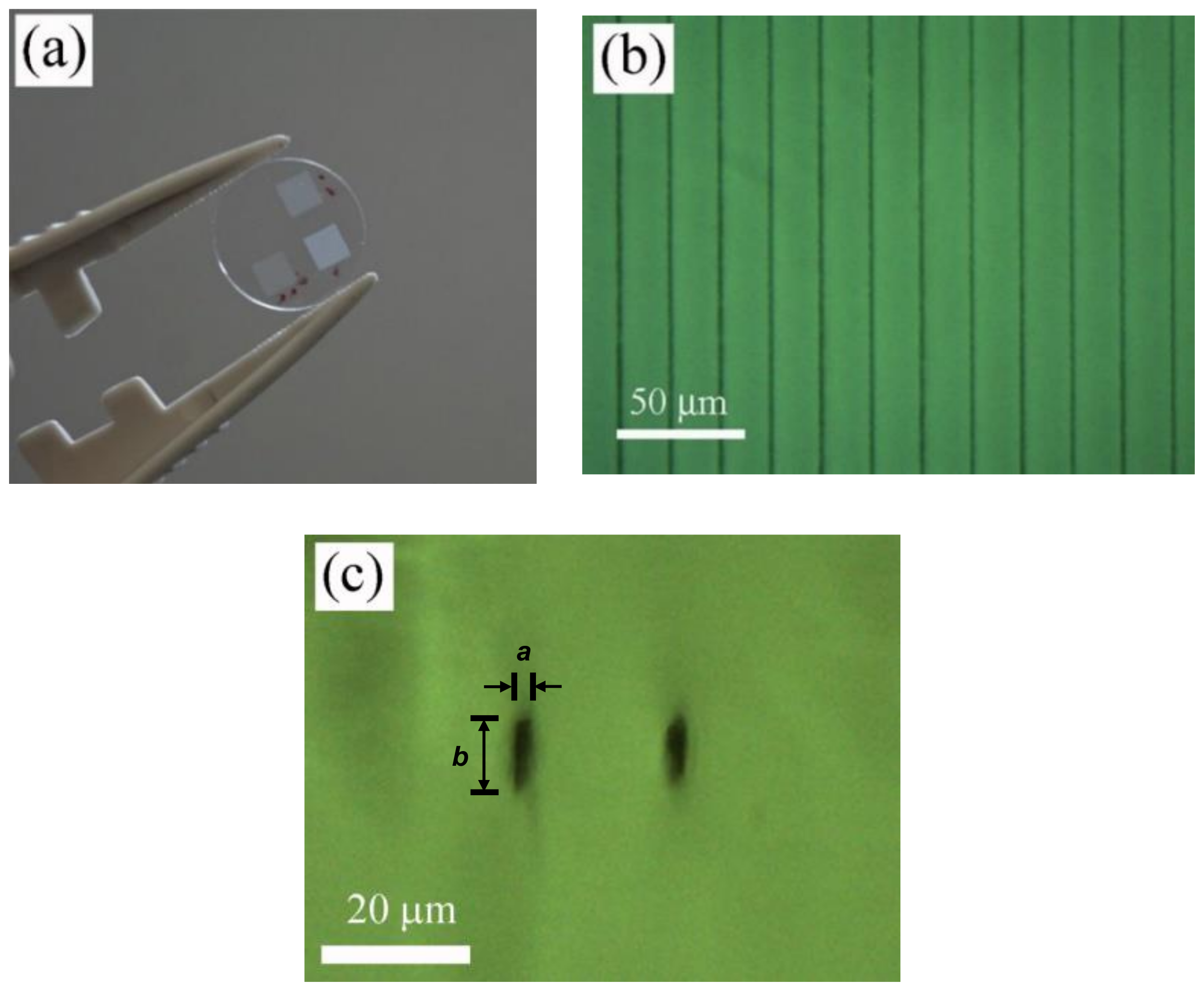
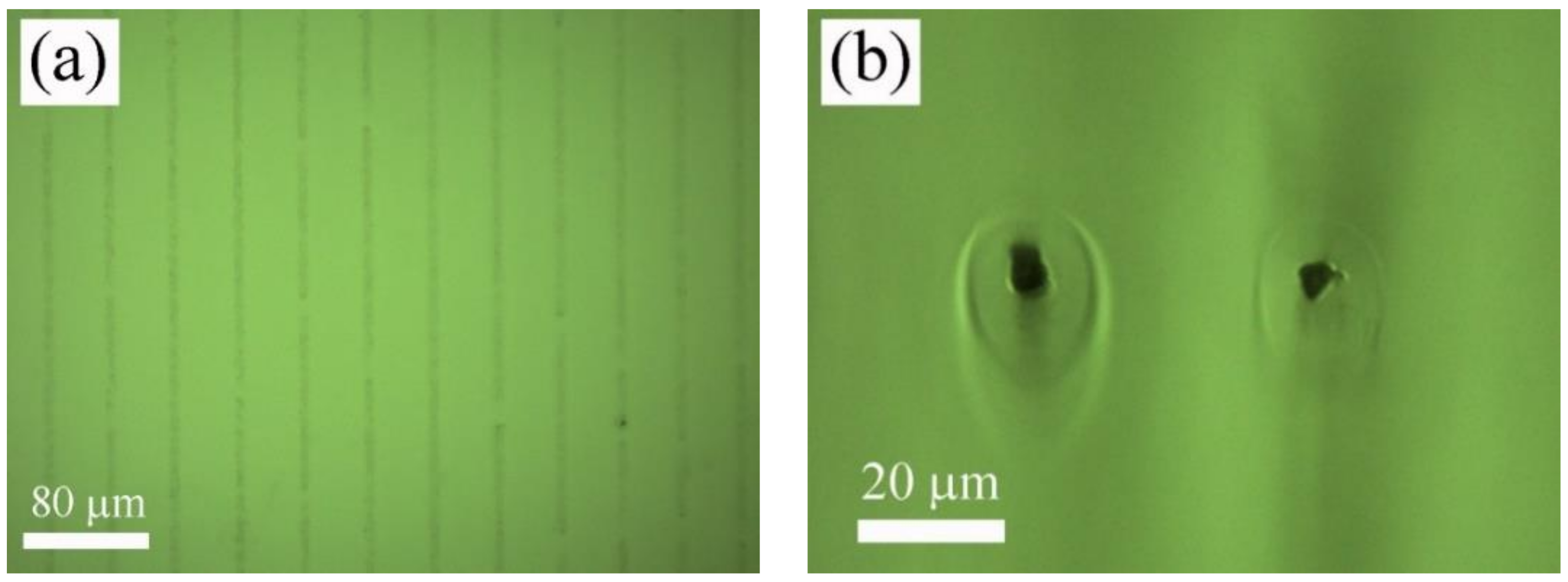
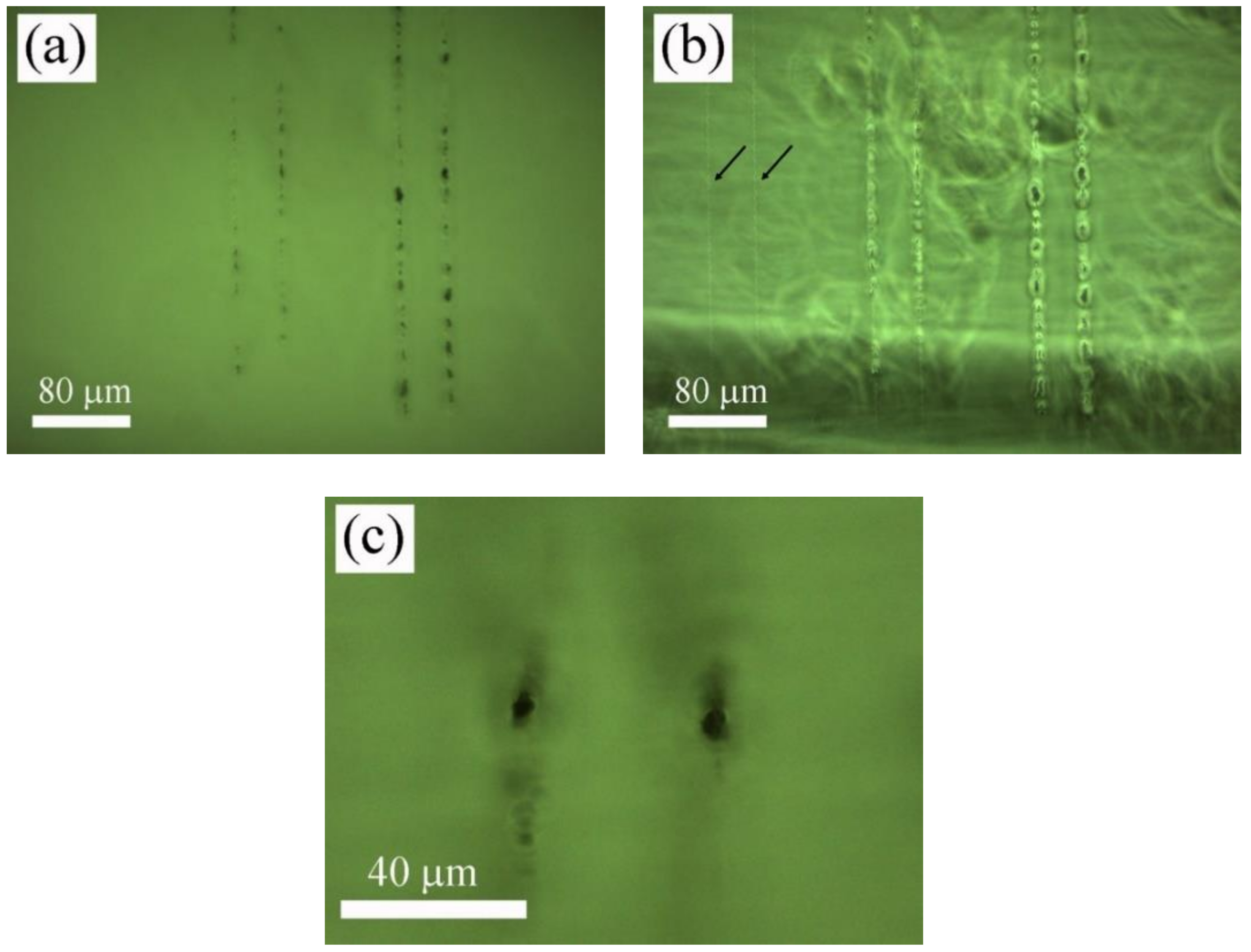
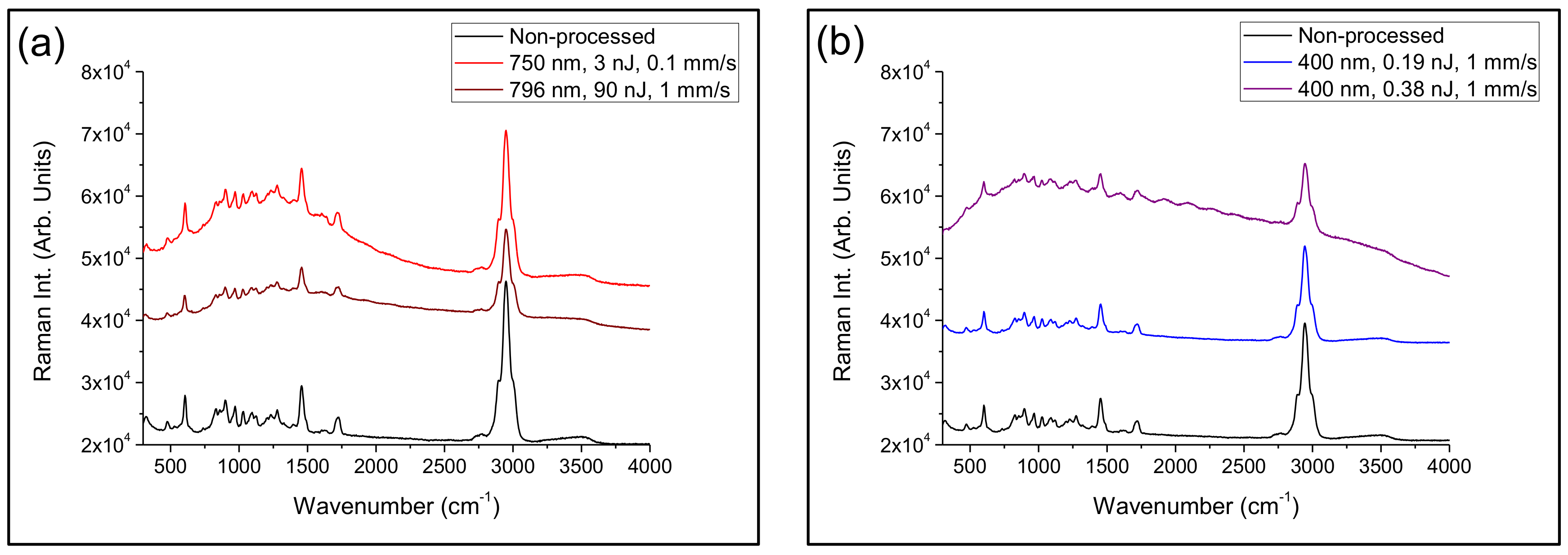
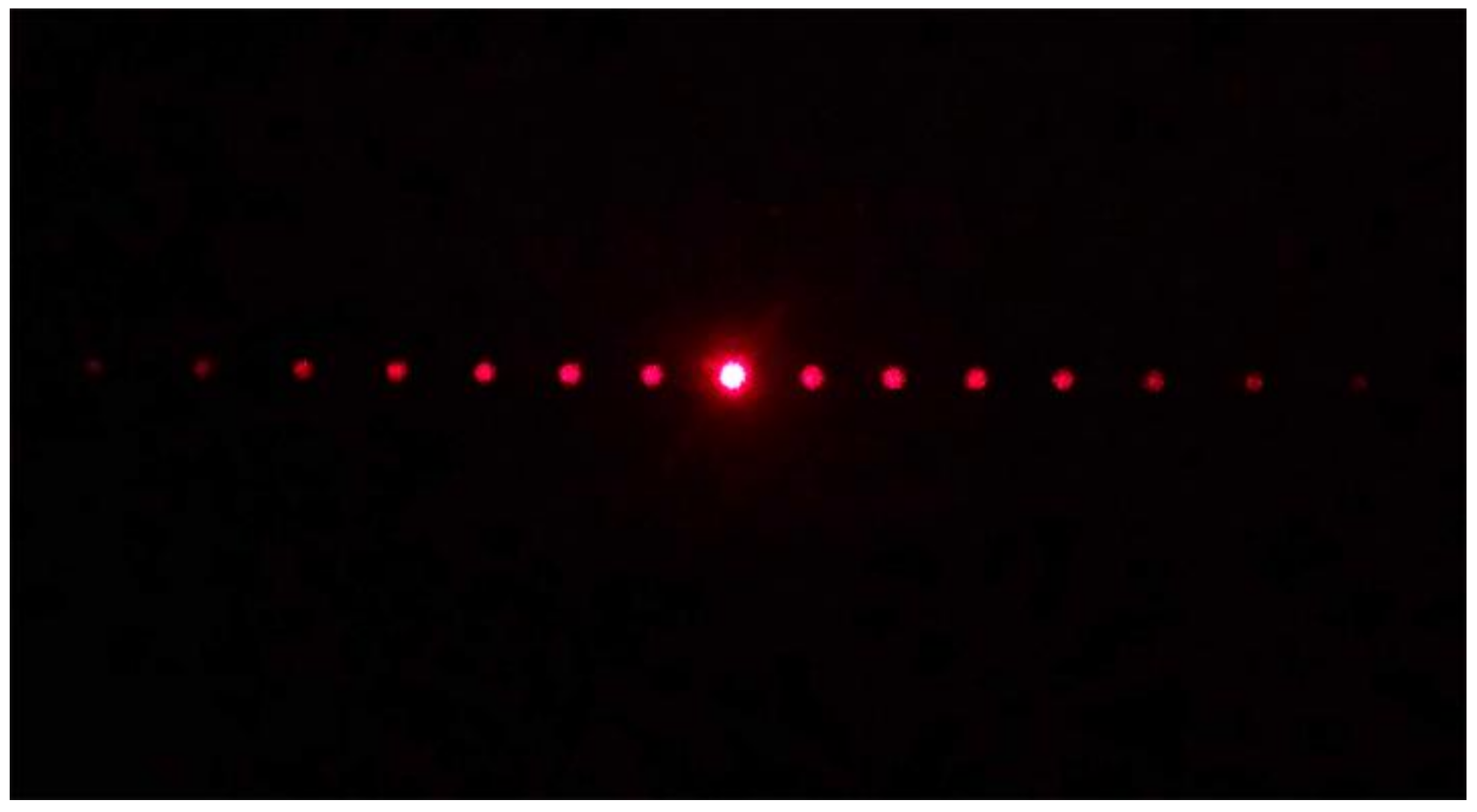
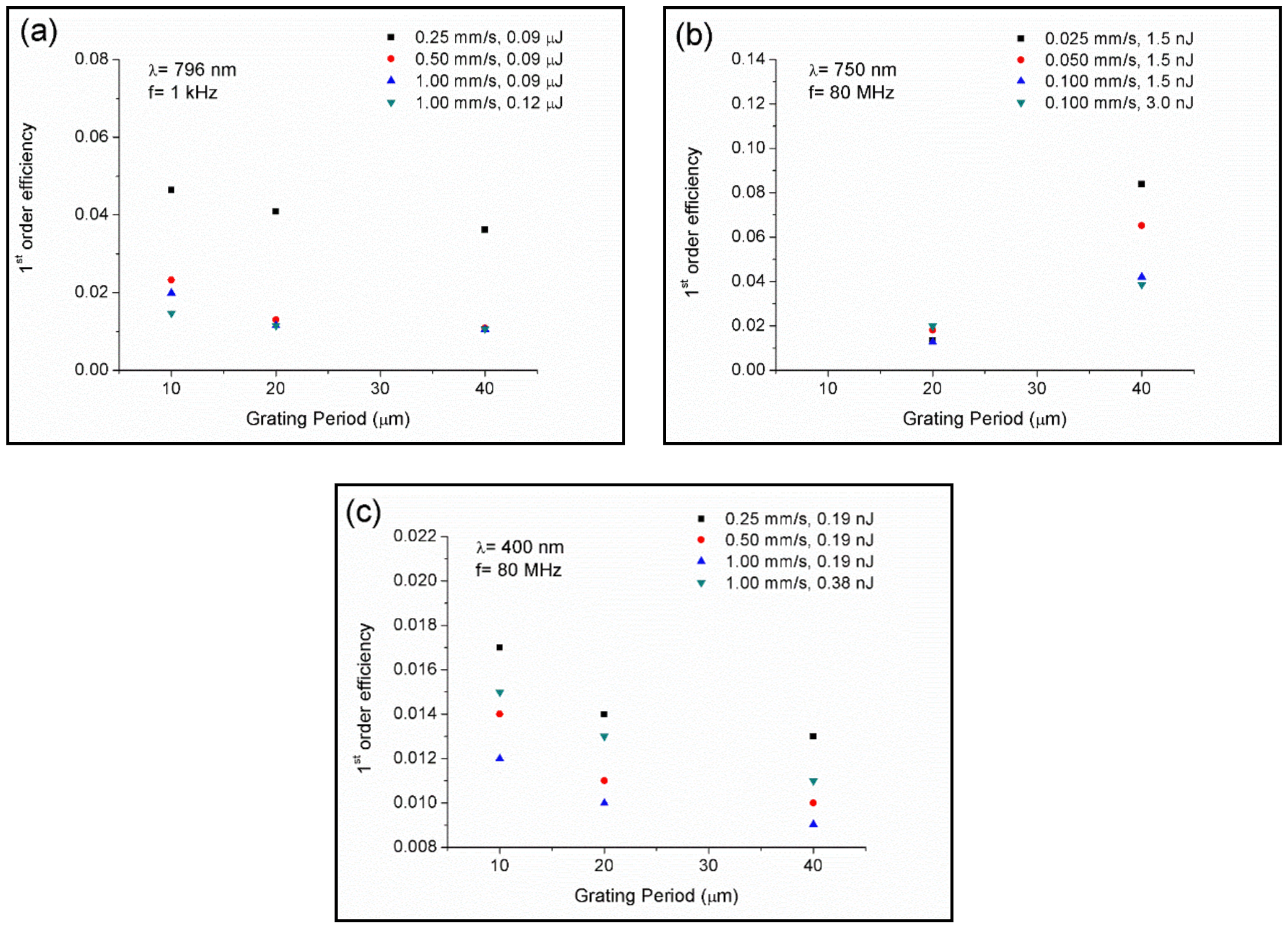
| Laser Source | Wavelength (nm) | Repetition Rate (kHz) | Scanning Speed (mm/s) | Inter-Line Spacing (µm) | Pulse Energy (nJ) |
|---|---|---|---|---|---|
| Amplifier | 796 | 1 | 0.25, 0.5, 1 | 10, 20, 40 | 90, 120 |
| Oscillator | 750 | 80 × 103 | 0.025, 0.05, 0.1 | 20, 40 | 1.5, 3.0 |
| Oscillator | 400 | 80 × 103 | 0.25, 0.5, 1 | 10, 20, 40 | 0.19, 0.38, 0.75 |
Publisher’s Note: MDPI stays neutral with regard to jurisdictional claims in published maps and institutional affiliations. |
© 2020 by the authors. Licensee MDPI, Basel, Switzerland. This article is an open access article distributed under the terms and conditions of the Creative Commons Attribution (CC BY) license (http://creativecommons.org/licenses/by/4.0/).
Share and Cite
Sola, D.; Aldana, J.R.V.d.; Artal, P. The Role of Thermal Accumulation on the Fabrication of Diffraction Gratings in Ophthalmic PHEMA by Ultrashort Laser Direct Writing. Polymers 2020, 12, 2965. https://doi.org/10.3390/polym12122965
Sola D, Aldana JRVd, Artal P. The Role of Thermal Accumulation on the Fabrication of Diffraction Gratings in Ophthalmic PHEMA by Ultrashort Laser Direct Writing. Polymers. 2020; 12(12):2965. https://doi.org/10.3390/polym12122965
Chicago/Turabian StyleSola, Daniel, Javier R. Vázquez de Aldana, and Pablo Artal. 2020. "The Role of Thermal Accumulation on the Fabrication of Diffraction Gratings in Ophthalmic PHEMA by Ultrashort Laser Direct Writing" Polymers 12, no. 12: 2965. https://doi.org/10.3390/polym12122965
APA StyleSola, D., Aldana, J. R. V. d., & Artal, P. (2020). The Role of Thermal Accumulation on the Fabrication of Diffraction Gratings in Ophthalmic PHEMA by Ultrashort Laser Direct Writing. Polymers, 12(12), 2965. https://doi.org/10.3390/polym12122965







